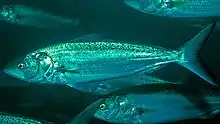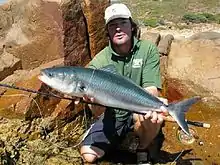Arripis trutta
Arripis trutta, known as kahawai in New Zealand and as the Australian salmon in Australia, is one of four species of marine fish within the genus Arripis, found in cooler waters around the south eastern and south western coasts of Australia and the New Zealand coastline. Although it is referred to as a salmon in Australia and its species epithet trutta is the Latin for trout, it is not related to salmons or trouts of the family Salmonidae. Other common names for this species include Eastern Australian salmon, bay trout, black back, blackback salmon, buck, buck salmon, cocky salmon, colonial salmon, newfish, and salmon trout.
| Arripis trutta | |
|---|---|
 | |
| Scientific classification | |
| Kingdom: | Animalia |
| Phylum: | Chordata |
| Class: | Actinopterygii |
| Order: | Perciformes |
| Family: | Arripidae |
| Genus: | Arripis |
| Species: | A. trutta |
| Binomial name | |
| Arripis trutta (J. R. Forster, 1801) | |
| Synonyms[1] | |
| |
Description
Arripis trutta is a streamlined fish with a long and slender body. There is a bony ridge edge of bone beneath and in front of each eye which has obvious serrations in smaller individuals. In larger fish the scales feel smooth. The lobes of the caudal fin are equivalent in length to the head. These fish are dark bluish-green dorsally and silvery white ventrally. The juveniles have golden bars on their upper flanks and these break up into large spots as the fish matures. The pectoral fin is vivid yellow and the caudal and spiny part of the dorsal fin both have a blackish margin.[2] There are 9 spines and 15-17 soft rays in the dorsal fin and 3 spinesand 9-10 soft rays in the anal fin. The maximum total length recorded is 89 centimetres (35 in) although they are commonly a total length of around47 centimetres (19 in) and the maximum recorded weight is 9.4 kilograms (21 lb).[1] The most consistent difference between this species and Arripis truttacea is the gill raker count, A. truttacea has 25-31 gill rakers and A trutta has 33-40.[2]
Distribution
Arripis trutta is found in the south western Pacific Ocean around Australia and New Zealand.[1] In Australia they are found from Moreton Bay in Queensland to western Victoria and northern Tasmania, with infrequent records at Kangaroo Island in South Australia. They are also found around Lord Howe Island and Norfolk Island in the Tasman Sea.[2] In New Zealand, they are distributed around the coast but are more common north of Kaikoura on the South Island.[3] They are also found around the Chatham Islands and Kermadec Islands.[1]
Habitat and biology
Arripis trutta are migratory fish which may migrate long distances, sometimes thousand of kilometres. The adults congregate in very large schools off oceanic beaches and exposed coasts form vast schools along oceanic beaches and exposed areas coastal areas.[2] They will enter rivers.[1] The juveniles live in smaller schools in more sheltered areas such as bays and estuaries, and these mostly occur in the more southerly areas in which this species occurs. It is a carnivorous species which feeds mainly on small pelagic fish and pelagic crustaceans such as krill.[2] They are highly visual predators, preying on a diverse variety which eat a variety of crustaceans and polychaetes during their juvenile phase, however, adults shift their preferred prey to small schooling fish, baitfish such as pilchards, sprats and anchovies. There is some evidence that the diet of A. trutta has undergone a marked shift since the late 20th Century, studies conducted during 1950s and 1960s found that the adults fed largely on krill and squid, which are animals associated with cooler waters. Studies during the early 21st Century have shown that the main prey taken is small pelagic baitfish. It is thought that this shift is a result of long-term changes in the East Australian Current which brings warmer waters from the Coral Sea and has extended farther south since the 1990s. It is further thought that his “multi-decadal southward penetration of the EAC” is one of the more obvious indications of global warming and the recorded change in the diet of A trutta forms a biological record of global warming.[4]
Arripis trutta are preyed on by larger apex predators such as seals, dolphins and sharks. The feeding salmon schools push the schools of the fish they prey on towards the surface making them accessible to seabirds, In this way, this species has an important ecological role in facilitating transfer of energy among the upper levels of the pelagic food chain in inshore ecosystems.[4] An example is the white-fronted tern (Sterna striata) which has the colloquial name "kahawai bird" because often feeds on shoaling fish in association with kahawai, gulls and shearwaters. Fishermen hunting for schools of kahawai to troll look out for the flocks of white-fronted terns feeding in association with the predatory fish.[5]
The Australian population of this species spawns in the surf zone between Lakes Entrance in Victoria and Bermagui in New South Wales in the late spring and summer. The first spawn when they are around four years old and have attained a length of 39 centimetres (15 in)/[6] They can live for up to 26 years.[1]
Fisheries
Arripis trutta are caught in coastal waters, frequently in the vicinity of estuaries and off coastal beaches. Most of the commercial landings are caught using purse seines and spotter planes may be used to find the large schools They may also be taken as bycatch of purse seine and trawl fisheries pursuing other schooling species like snapper, mackerel and trevally. Although they are fished for throughout southern Australia, the main landings are in southern New South Wales and Eastern Victoria. The flesh of this species is not very popular with consumers and a high proportion of the landings have been used as pet-food or bait.[7] In New Zealand the principal commercial fishing areas are north of Kaikoura in the South Island, off the coast of North Island and in the Cook Strait.[8] Fisheries New Zealand manages that nation's fishery to maintain the population of A trutta at roughly 52% of the stock which was present before modern commercial fisheries began and in 2019 the population was well above that target.[9]
Recreational fisheries
Arripis trutta are highly prized by recreational fishermen, especially for anglers fishing from beaches and rocks. Anglers tend to catch this species using light tackle or by fly fishing and it is said to be a "sporting catch".[10]
Species description
Arripis trutta was first formally described in 1801 as Sciaena trutta by Marcus Elieser Bloch and Johann Gottlob Theaenus Schneider with the type locality given as the Cook Strait.[11]
References
- Froese, Rainer and Pauly, Daniel, eds. (2019). "Arripis trutta" in FishBase. December 2019 version.
- Bray, D.J. (2018). "Arripis trutta". Fishes of Australia. Museums Victoria. Retrieved 21 April 2020.
- "Kahawai". Ocean Hunter. Retrieved 21 April 2020.
- Dr Ben Diggles (14 September 2016). "Fish Facts: Australian salmon". Fishing World. Retrieved 21 April 2020.
- "White-fronted tern". NZ Birds Online. Retrieved 21 April 2020.
- "Arripis trutta (Forster, 1801), Eastern Australian Salmon". Museums Victoria. Retrieved 21 April 2020.
- "Australian Salmon". goodfishbadfish. Retrieved 21 April 2020.
- "Kahawai". Seafood New Zealand. Retrieved 21 April 2020.
- "Kahawai". Fisheries New Zealand. Retrieved 21 April 2020.
- "Catching & Fishing for Australian Salmon (Arripis trutta)". Sea-Ex. Retrieved 2 April 2020.
- Eschmeyer, William N.; Fricke, Ron & van der Laan, Richard (eds.). "Sciaena trutta". Catalog of Fishes. California Academy of Sciences. Retrieved 21 April 2020.
